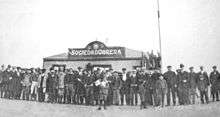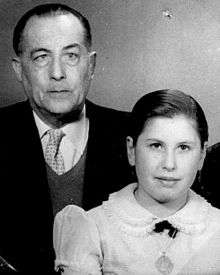Antonio Soto (syndicalist)
| Antonio Soto Canalejo | |
|---|---|
 | |
| Born |
8 October 1897 Ferrol, La Coruña, Kingdom of Spain |
| Died |
11 May 1963 (aged 65) Punta Arenas, Magallanes Province, Chile |
| Resting place |
Cemetery of Punta Arenas 53°09′10″S 70°53′51″W |
| Other names | El Gallego |
| Citizenship | Argentine and Spanish |
| Known for | Patagonia Rebelde (Rebel Patagonia) |
| Movement |
Anarchism Anarcho-syndicalism Socialism |
| Children | Isabel Soto |
Antonio Soto Canalejo (8 October 1897 – 11 May 1963), also known as "El Gallego Soto", was one of the principal anarcho-syndicalist leaders in the rural strikes in the Patagonia of Argentina in 1921.
Biography
Early years and youth
Antonio Soto was born on 8 October 1897 in the Galician village of Ferrol (La Coruña) to Antonio Soto and Concepción Canalejo. He arrived in Buenos Aires when he was 13 years old. Fatherless, he began a life of misery and privation in Argentina. Soto was unable to complete much of primary school. He worked in a diverse variety of jobs, suffering exploitation and punishments. Ever since he was a boy, he was attracted to anarchist ideas, particularly those of the syndicalists. In 1914, when Soto was 17 years old, Soto refused to join the Spanish militia to go and fight Morocco. In 1919 he embarked with the theater company Serrano-Mendoza, which visited the different Patagonic ports in Argentina and Chile.
In January 1920, a popular rebellion broke out in Trelew, Chubut. It began with a strike by commercial employees which grew in support by most of the population against the governor, the police, and the large traders. Soto arrived and began to agitate and support the striking workers, which lead to his arrest and expulsion from Chubut. Soon after he arrived in Río Gallegos, where the militant labor climate that reigned in the city attracted him.
Early Political career
Before and after the theatrical performances, Soto attended meetings of la Sociedad Obrera de Río Gallegos (Workers Society of Río Gallegos). There he would listen to Doctor José María Borrero who was a captivating orator, who suggested Soto stay and join the union. Borrero had realized that Soto was a militant who had a good ideological foundation and who knew how to express himself in the union's assemblies. Soto abandoned the theater company and settled in the Patagonia, where he enrolled as a longshoreman to work in the port.

On 24 May 1920 he was chosen as Secretary General of the Workers Society of Río Gallegos. In July of that year the Workers Society, in agreement with all of the unions in the rest of the province of Santa Cruz, declared a strike of all hotel personnel and dockworkers, demanding improved wages. While the dockworkers lost the strike, but the union of waiters, peasants and cooks of the hotels continued.
Involvement in the First Patagonic Strike
The situation at the beginning of 1921 was as follows: the strike in Río Gallegos and Puerto Deseado was a general strike. In addition, they had declared a boycott of three shops. On 16 January, the marine Malerba, under orders of the governor Edelmiro Correa Falcón began a suppression of the striking workers. The advisor of the Workers Society, José María Borrero, is detained, along with other members, but Soto was able to avoid arrest.
Soto traveled clandestinely to Buenos Aires to discuss the situation in the union congress. The Organización Obrera, the official newspaper of the syndicalist FORA, published news of his arrival. He participated in the national congress as a delegate of the Workers Society of Río Gallegos, where he sought support and solidarity for the conflict in Santa Cruz. The congress, with representatives from across the country, occurred in La Plata from 29 January until 5 February. Soto criticized the congress for the lack of solidarity for the labor movement in the Patagonia.
The Radical government of Hipólito Yrigoyen, allied with the big landowners, sent the army to the Patagonia, commanded by Lieutenant Colonel Héctor Benigno Varela to evaluate the developing situation. Upon arrival and evaluation of what led up to the strike, Varela informed the government that the landowners were at fault for the exploitation that they subjected the rural workers to and that they ought to improve working conditions. He obligated both sides to lay down their arms and for the landowners to comply with the workers' demands. Upon completion of his duties, Varela returned to Buenos Aires.
Involvement in the Second Patagonic Strike
The landowners refused to comply with the agreement and continued with the layoffs, held the back pay, and maintained the poor working conditions. Soto led the Workers Society to strike for an indefinite period of time. On 25 March 1921, a general strike was declared. The landowners and the outgoing governor Correa agitated for the return of Lieutenant Colonel Varela to Santa Cruz, whereupon he began to repress and massacre the striking workers.
On 15 September 1921, Soto and his comrades depart, heading towards the farms of the cordillera of the Andes in a long journey with cars and horses. On 31 October, he had managed to incorporate into the movement the rural workers of several large farms, driving the southeast of Santa Cruz into an uprising. They requisitioned arms and food for the campaign, granting vouchers promising to eventually return the goods and occasionally taking the landowners and managers hostage. On 5 November, all of the farms in the south of Santa Cruz were totally paralyzed. Workers took control of the roads, moving in columns of 60, 100, and 200 men who marched under the black and red flag. Soto met with the anarchist militants Graña, Sambucetti and Mongilnitzky, whereupon they decided that while Soto would continue leading the movement in the countryside, the latter three would try to enter Río Gallegos to replace the arrested leaders and to serve as a point of support within the city. When the three men entered Río Gallegos, they were beaten and arrested by the police. Meanwhile, the workers columns of Pintos, Ramón Outerello, and Albino Argüelles were attacked by the soldiers of Varela, suffering dozens of casualties.
The movement was divided into two parts: the column of Antonio Soto and the column of José Font (better known as Facón Grande). Until the beginning of December, Soto had dominated all the area south of Argentino Lake and of the Viedma Lake, and his contingent was the biggest (with around 600 workers). They operated from the estancia La Anita.[1]
On 7 December, the army was nearby and the workers met in an assembly. Juan Farina, a Chilean worker, proposed that they surrender to the army and a majority of the peasants supported the decision. Soto argued that it was necessary to continue the strike, but ultimately agrees to send two men to parley with the army and to discuss surrender, guarantees, and the fulfilment of the terms of the agreement made by Varela the year before. Upon arrival at the military encampment, the two men were immediately executed.[2]
When the army arrived at estancia La Anita and demanded the unconditional surrender of all of the striking workers. The leaders of the strike met in an assembly, where Soto gave a dramatic speech but was ultimately ignored by a majority of the assembly, who eventually decided to surrender and end the strike. Upon their surrender, Varela's troops executed a large number of the workers. Soto and twelve men escaped on horseback to Chile and was never captured by the authorities.[3]
Life in Chile and Final years

The Argentine military and Carabiniers of Chile pursued Soto for five days, but he managed to hide in Puerto Natales and was able to escape to Punta Arenas on a schooner, protected by allies in the Federación Obrera de Magallanes, a local trade union. Fearing capture, he escaped on a boat and made his was to Valparaíso with the ultimate destination of Iquique in the north of Chile where he worked in a saltpeter refinery. The difficult working conditions took a toll on his health, leading him to return to Valparaíso.
In 1933 he traveled incognito to Río Gallegos to explain his involvement in the 1921 strike, where he made contact with his comrades and prepared an act that was, compared to the previous strike, a disaster. Soto was immediately expelled from the province by the governor Gregores. In exile, he became less militant but never broke with anarchism.[4]
Soto settled in Punta Arenas and managed a small hotel, which served as a meeting place of libertarians, intellectuals, and free-thinkers. He also founded the Centro Republicano Español, the Centro Gallego, a branch of the Red Cross, and a cinema named Libertad.[3] On 11 May 1963, Soto died in Punta Arenas at age 65. His funeral was attended by libertarians, republicans, and students (Soto had inspired the first students' strike in Punta Arena in support of a higher wage for teachers). His tombstone can be found in the Cementerio Municipal de Punta Arenas.
In his hometown, Ferrol (Galicia), there is a street named after him.
See also
References
- ↑ Osvaldo Bayer, La Patagonia Rebelde. Tomo II, p. 195-238, Booket, Buenos Aires, 2004, ISBN 987-1144-71-7.
- ↑ Osvaldo Bayer, La Patagonia Rebelde. Tomo II, Booket, Buenos Aires, 2004, ISBN 987-1144-71-7.
- 1 2 Bayer, Osvaldo (2007): «La segunda vuelta de Antonio Soto», artículo del 13 de octubre de 2007 en el diario Página/12 (Buenos Aires).
- ↑ Bayer, Osvaldo (2004): La Patagonia Rebelde, tomo III, págs. 203–240. Buenos Aires: Booket, 2004. ISBN 987-1144-71-7